EM w/ 2 univariate Gaussians
Published:

MindNote - Machine Learning - Unsupervised Learning - Clustering
Author: Christian M.M. Frey
E-Mail: christianmaxmike@gmail.com
Mixture Model w/ 2 Gaussians
In general, in a gaussian mixture model each base distribution in the mixture is multivariate gaussian with mean $\mu_k$ and covariance matrix $\Sigma_k$. Thus, the complete model has the form: \(p(x_i | \theta) = \sum_{k=1}^{K} \pi_k \mathcal{N}(x_i | \mu_k, \Sigma_k)\)
In this tutorial we want to have an insight in the gaussian mixture model when using 2 gaussians $\mathcal{N}(\mu_1, \sigma_1^2)$ and $\mathcal{N}(\mu_2, \sigma_2^2)$. Hence, we need to estimate 5 parameters $\theta=(\boldsymbol{\pi}, \mu_1, \sigma_1^2, \mu_2, \sigma_2^2)$, where $\pi_1$ is the probability that the data $x$ comes from $\mathcal{N}(\mu_1, \sigma_1^2)$ and $\pi_2 = 1-\pi_1$ is the probability that the data was generated by $\mathcal{N}(\mu_2, \sigma_2^2)$. Therefore, the probability density function (PDF) of the mixture model is given by:
\[f(x | \theta) = \pi_1 f_1(x | \mu_1, \sigma_1^2) + \pi_2 f_2(x | \mu_2, \sigma_2^2)\]Load dependencies
import matplotlib.pyplot as plt
import matplotlib as mpl
import seaborn as sns
sns.set()
%matplotlib inline
import numpy as np
from scipy import stats
import pandas as pd
from math import sqrt,log,exp,pi
mpl.rcParams['axes.titlesize'] = "large"
sns.set_context("notebook", font_scale=1.2)
Generate data
np.random.seed(42)
# params for the first gaussian
mu_1 = 0
sigma_1 = 3
# params for the second gaussian
mu_2 = 7
sigma_2 = 2
# data generated from N(mu_1, sigma_1^2) and N(mu_2, sigma_2^2)
y_1 = np.random.normal(mu_1, sigma_1, 1000)
y_2 = np.random.normal(mu_2, sigma_2, 1000)
# concat data
data = np.concatenate((y_1, y_2))
# subdivide space
x = np.linspace(min(data), max(data), 2000)
# plot data
sns.distplot(data, bins=50, kde=False)
plt.title("Visualizing the data distribution")
<matplotlib.text.Text at 0x1141e92b0>

Next, we will implement a class representing an univariate guassian. The probability density function of a gaussian is given by: \(f(x; \mu, \sigma^2)\frac{1}{\sqrt{2 \pi \sigma^2}} \cdot e^{- \frac{(x - \mu)^2}{2 \sigma^2}}\)
class Gaussian (object):
"""
Class for an univariate gaussian
Arguments:
mu: mean of the gaussian
sigma: standard deviation of the gaussian
Properties:
mu: mean of the gaussian
"""
def __init__(self, mu, sigma):
self.mu = mu
self.sigma = sigma
def pdf(self, x):
"""
Calculates the probability density function of the gaussian
Arguments:
x : pdf is calculated for falling within the infitesimal
interval [x, x + dx]
Returns:
pdf(x) - probability density function evaluated for x being
attached as parameter
"""
return (1/sqrt(2 * pi * self.sigma**2)) * exp( - (x-self.mu)**2 / (2 * self.sigma**2))
def __str__(self):
"""
Textual representation of the gaussian
Returns:
string representation of the object
"""
return "N ({0:.2f}, {1:.2f})".format(self.mu, self.sigma)
Fit the data with 1 gaussian
g_1 = Gaussian(np.mean(data), np.std(data))
print (g_1)
N (3.60, 4.34)
# iterate values in 'x' and calculate the pdf values for each x_i
g_1_pdfs = []
for x_i in x:
g_1_pdfs.append(g_1.pdf(x_i))
sns.distplot(data, bins=20, kde=False, norm_hist=True)
plt.plot(x, g_1_pdfs)
plt.legend()
/Users/ChrisMaxMike/anaconda/lib/python3.6/site-packages/matplotlib/axes/_axes.py:545: UserWarning: No labelled objects found. Use label='...' kwarg on individual plots.
warnings.warn("No labelled objects found. "

EM for GMMs
We will no discuss how to fit a mixture of Gaussians using EM. We assume the number of mixture components, $K$, is known.
The Expectation step:
The E Step has the following simple form, which is the same for any mixture model: \(r_{ik} = \frac{\pi_k p(x_i | \theta_k^{(t-1)})}{\sum_{k'} \pi_{n'} p (x_i | \theta_{k'}^{(t-1)})}\)
where $r_{ik} \triangleq p(z_i = k |x_i, \theta^{(t-1)})$ is the $\textbf{responsibility}$ that cluster $k$ takes for data point $i$.
The M step:
In the M step, we optimize the log likelihood wrt $\pi$ and the $\theta_k$. For $\pi$, we have: \(\pi_k = \frac{1}{N} \sum_{i} r_{ik} = \frac{N_k}{N}\)
where $N_k \triangleq \sum_{i} r_{ik}$ is the weighted number of points assigned to cluster $k$.
\[\mu_k^{new} = \frac{1}{N_k}\sum_{n=1}^{N} r_{ik}x_n\] \[\Sigma_{k}^{new} = \frac{1}{N_k}\sum_{n=1}^{N}r_{ik} (x_n - \mu_k^{new})(x_n - \mu_{k}^{new})^T\]In the last step we evaluate the log likelihood and check for convergence of either the parameters or the log likelihood. If the convergence criterion is not satisfied, we continue with the E-step.
\[ln \; p(X|\mu, \Sigma, \pi) = \sum_{n=1}^{N}ln \{\sum_{k=1}^{K} \pi_k \mathcal{N}(x_n | \mu_k, \Sigma_k)\}\]class GaussianMixture(object):
""" Class for modeling a gaussian mixture model w/ 2 gaussians
Arguments:
data: input data
pi_1: weight for the first gaussian distribution (pi_2 will be 1-pi_1)
seed: random seed
Properties:
data: data used for the mixture model
g1: first gaussian model
g2: second gaussian model
pi_1: weight for the first gaussian model g1
pi_2: weight for the second gaussian model g2
loglike: log-likelihood of the distribution
"""
def __init__ (self, data, pi_1 = .5, seed=42):
self.data = data
np.random.seed(seed)
self.g1 = Gaussian(np.random.uniform(min(data), max(data)), 1)
self.g2 = Gaussian(np.random.uniform(min(data), max(data)), 1)
self.pi_1 = pi_1
self.pi_2 = (1-pi_1)
def EStep(self):
"""
performs the estimation step of the EM algorithm.
Assigns each point to the mixture model with a precentage.
"""
self.loglike = 0
for d in self.data:
w1 = self.g1.pdf(d) * self.pi_1
w2 = self.g2.pdf(d) * self.pi_2
denominator = w1 + w2
w1 /= denominator
w2 /= denominator
self.loglike += log (w1+w2)
yield (w1, w2)
def MStep(self, weights):
"""
performs an maximization-step
"""
(left, right) = zip(*weights)
g1_d = sum(left)
g2_d = sum(right)
# mu new
self.g1.mu = sum(w * d for (w, d) in zip(left, self.data)) / g1_d
self.g2.mu = sum(w * d for (w, d) in zip(right, self.data)) / g2_d
# compute new sigmas
self.g1.sigma = sqrt(sum(w * ((d - self.g1.mu) **2) for (w,d) in zip(left, self.data)) / g1_d)
self.g2.sigma = sqrt(sum(w * ((d - self.g2.mu) **2) for (w,d) in zip(right, self.data)) / g2_d)
# compute new weights
self.pi_1 = g1_d / len(self.data)
self.pi_2 = g2_d / len(self.data)
def _calculate_loglike(self):
"""
calculates the log likelihood of the model; the calculation is performes the same as in the
E step
"""
self.EStep()
def evaluate(self):
"""
performs an iteration of of the EM algorithm
"""
self.MStep(self.EStep())
self._calculate_loglike()
def pdf(self, x):
"""
Computes the probability density function for this gaussian
mixture model.
Arguments:
x : data for which the pdf is calculated
Returns:
pdf(x) - probability density function evaluated for the input
data x being attached as parameter
"""
return (self.pi_1)* self.g1.pdf(x) + (self.pi_2)*self.g2.pdf(x)
def __str__(self):
return ("=== \n Gaussian Mixture Model: \n " +
"\t {pi1:.2f} of Gaussian: {g1} \n".format(pi1=self.pi_1, g1=self.g1) +
"\t {pi2:.2f} of Gaussian: {g2} \n".format(pi2=self.pi_2, g2=self.g2) +
"===")
def plot_mixture_model(data, x, mixture_model, title=""):
"""
method for plotting the mixture model consisting of 2 gaussians
Arguments:
data: input data being used for the mixture model
x: equal linespaced values used for computing the values of the gaussian models
mixture_model: mixture model having been computed
title: title of the plot
"""
plt.figure(figsize=(8,6))
plt.title(title)
plt.xlabel("$x$")
plt.ylabel("$pdf(x)$")
# plot data
sns.distplot(data, bins=20, kde=False, norm_hist=True)
# plot first gaussian model
g1 = [mixture_model.g1.pdf(x_i) * mixture_model.pi_1 for x_i in x]
plt.plot(x, g1, linewidth=3, label='Gaussian:{}'.format(str(mixture_model.g1).replace("N", r"$\mathcal{N}$")));
# plot second gaussian model
g2 = [mixture_model.g2.pdf(e) * mixture_model.pi_2 for e in x]
plt.plot(x, g2, linewidth=3, label='Gaussian:{}'.format(str(mixture_model.g2).replace("N", r"$\mathcal{N}$")));
#plot mixturem model
gmm_vals = [mixture_model.pdf(x_i) for x_i in x]
plt.plot(x, gmm_vals, linewidth=3, label='Mixture Model ($\pi$:[{0:4.2}; {1:4.2}])'.format(mixture_model.pi_1, mixture_model.pi_2));
# show legend
plt.legend();
n_iter = 100
best_mixture_model = None
best_loglike = float('-inf')
mixture_model = GaussianMixture(data, seed=66)
for i in range(1, n_iter+1):
mixture_model.evaluate()
if i % 10 == 0:
plot_mixture_model(data, x, best_mixture_model, title="Mixture model after {i} iterations \nLog Likelihood {log:.8f} ".format(i=i, log=best_mixture_model.loglike))
if mixture_model.loglike > best_loglike:
best_loglike = mixture_model.loglike
best_mixture_model = mixture_model


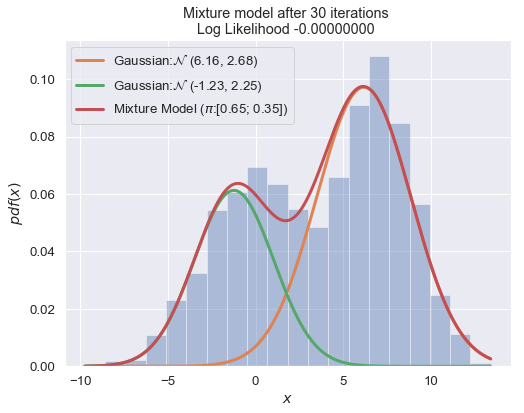
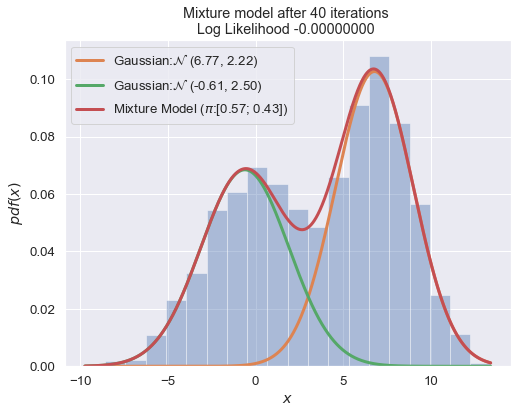
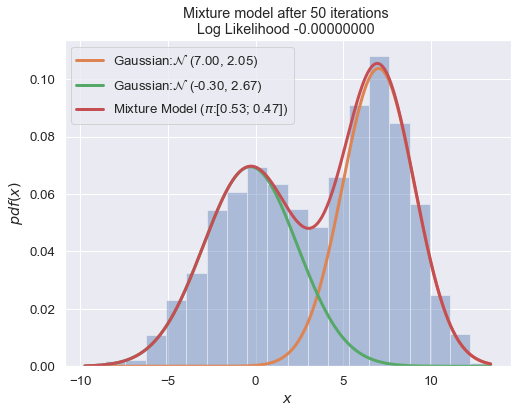
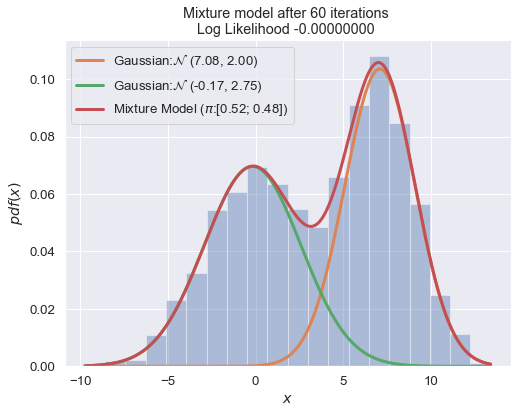

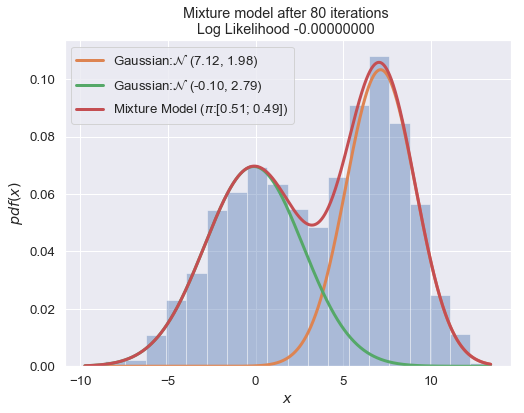
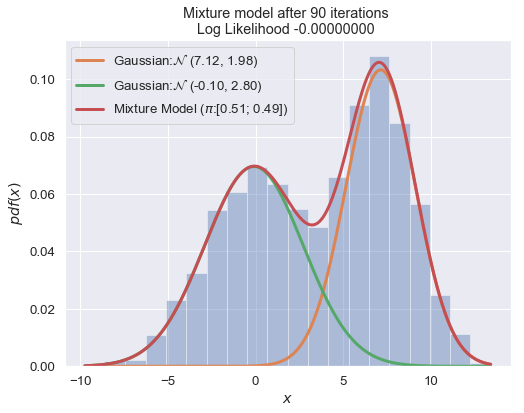

print (best_mixture_model)
===
Gaussian Mixture Model:
0.51 of Gaussian: N (7.12, 1.98)
0.49 of Gaussian: N (-0.09, 2.80)
===
